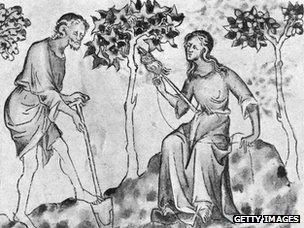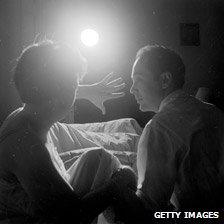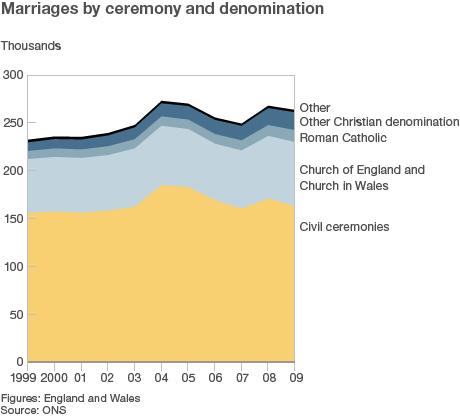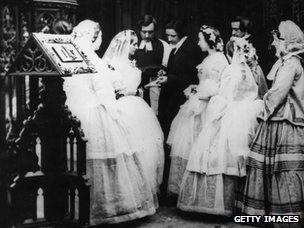Ten key moments in the history of marriage
- Published

At the very heart of the debate about same-sex marriage is the definition of the word "marriage". To some people, it changes to meet social and economic needs, to others it remains firmly fixed. So what has the institution meant down the years?
Much of the recent debate has focused on the notion of who "owns" marriage - the Church or the State. Both, however, have played key roles at different times in the history of the institution.
1. Strategic alliances

An Anglo-Saxon wife spins, while the farmer or "husbandman" cultivates the ground
For the Anglo-Saxons and Britain's early tribal groups, marriage was all about relationships - just not in the modern sense. The Anglo-Saxons saw marriage as a strategic tool to establish diplomatic and trade ties, says Stephanie Coontz, author of Marriage, A History: How Love Conquered Marriage. "You established peaceful relationships, trading relationships, mutual obligations with others by marrying them," Coontz says.
This all changed with the differentiation of wealth. Parents were no longer content to marry their children off to just "anyone in a neighbouring group". They wanted to marry them to somebody as least as wealthy and powerful as themselves, Coontz says. "That's the period when marriage shifts and becomes a centre for intrigue and betrayal."
2. Consent
During the 11th Century, marriage was about securing an economic or political advantage. The wishes of the married couple - much less their consent - were of little importance. The bride, particularly, was assumed to bow to her father's wishes and the marriage arrangements made on her behalf.
However, for the Benedictine monk Gratian the consent of the couple mattered more than their family's approval. Gratian brought consent into the fold of formalised marriage in 1140 with his canon law textbook, Decretum Gratiani.
The Decretum required couples to give their verbal consent and consummate the marriage to forge a marital bond. No longer was a bride or groom's presence at a ceremony enough to signify their assent.
The book formed the foundation for the Church's marriage policies in the 12th Century and "set out the rules for marriage and sexuality in a changing social environment", says historian Joanne Bailey of Oxford Brookes University.
3. The sacrament of marriage
As early as the 12th Century, Roman Catholic theologians and writers referred to marriage as a sacrament, a sacred ceremony tied to experiencing God's presence. However, it wasn't until the Council of Trent in 1563 that marriage was officially deemed one of the seven sacraments, says Elizabeth Davies, of the Catholic Bishops' Conference of England and Wales.
Following the development of Protestant theology, which did not recognise marriage as a sacrament, the Council felt a need to "clarify" marriage's place. "There was an underlying assumption that marriage was a sacrament, but it was clearly defined in 1563 because of the need to challenge teaching that suggested it wasn't," Davies says.
4. Wedding vows

In sickness and in health
Marriage vows, as couples recite them today, date back to Thomas Cranmer, the architect of English Protestantism. Cranmer laid out the purpose for marriage and scripted modern wedding vows nearly 500 years ago in hisBook of Common Prayer, says the Reverend Duncan Dormor of St John's College at the University of Cambridge.
Although the book was revised in 1552 and 1662, "the guts of the marriage service are there in 1549," he says. "All the things that you think of, 'to have and to hold, from this day forward, for better, for worse, for richer, for poorer', all of that stuff comes from that point." The marriage service has had "remarkable continuity" compared with most other services, he says.
But much of it was "pilfered from Catholic medieval rites", such as the Sarum marriage liturgy, which was all in Latin except the actual vows. "What makes the 1549 service significant is that it is the introduction of a Protestant service in English, and it's basically the words that we all know with a couple of small tweaks," Dormor says.
5. Divorce

Collecting evidence for a divorce
Before 1858, divorce was rare. In 1670, Parliament passed an act allowing John Manners, Lord Roos, to divorce his wife, Lady Anne Pierpon. This created a precedent for parliamentary divorces on the grounds of the wife's adultery, according to theNational Archives, external.
This marked "the start of modern 'divorce'," says Rebecca Probert of the University of Warwick School of Law.
It also set the precedent for more than 300 cases between the late 17th and mid-19th Centuries - each requiring an act of Parliament. It was only in 1858 that divorce could be carried out via legal process. Even then divorce was too expensive for most people, and there was the added challenge for wives of proving "aggravated" adultery - that their husbands had been guilty of cruelty, desertion, bigamy, incest, sodomy or bestiality, Probert says.
The gates for divorce opened with the Divorce Reform Act of 1969. Instead of pointing the finger, couples could cite marital breakdown as the reason for the split.
"Prior to 1969, the script was that marriage was for life" says Bren Neale, a University of Leeds sociologist. "The divorce law meant that people trapped in bad marriages need not stay in them forever." The emphasis on marriage shifted from a long-term commitment at all costs to a personal relationship where individual fulfilment is important, she says.
6. State control
The Clandestine Marriage Act of 1753, popularly known as Lord Hardwicke's Act, marked the beginning of state involvement in marriage, says sociologist Carol Smart of the University of Manchester. "You've got these parallel strands going on of the secular and the religious sides, and that clearly hasn't gone away," Smart adds.
The act required couples to get married in a church or chapel by a minister, otherwise the union was void. Couples also had to issue a formal marriage announcement, called banns, or obtain a licence.
Most prospective newlyweds were already following these directives, which were enshrined in canon law. But with the act, "the penalty for not complying became much, much harsher," Probert says.
"You can see it as the state increasing its control - this is almost too important just to leave to canon law, this needs a statute scheme and specific penalties if you don't comply," she says. "[It] put the formalities required for a valid marriage on a statutory footing for the first time."
7. Civil marriages

The Marriage Act of 1836 allowed for non-religious civil marriages to be held in register offices. These were set up in towns and cities across England and Wales. The act also meant nonconformists and Catholic couples could marry in their own places of worship, according to their own rites. Apart from a brief period during the 17th Century, marriages had been overseen by the Church of England - even if the couples weren't members.
"If you were Baptist, you might not want to get married in the Church of England but that was what you had to do," Probert says. "There's no point in going through a ceremony that didn't give you the status of a married couple."
The state also started keeping national statistics for marriage around this time. Non-Anglican couples were required to have a civil official present to document their marriages. "They're not actually trusted, in a sense, to record marriages themselves," Probert says.
8. Love enshrined

The Victorians fell in love with the notion of love
Roaming bards sang of love during medieval times and Shakespeare's Romeo and Juliet acted it out on stage, but it wasn't until the Victorian era that it became accepted as a foundation for marriage. "The Victorians were really, really invested in the idea of love - that marriage should actually be based on love or companionship," says Jennifer Phegley, author of Courtship and Marriage in Victorian England.
The growing importance of the middle class and new money blurred the traditional social boundaries for marriage. With more social mobility, there was a growing "distaste" among the middle classes for thinking of marriage as "a family-arranged event for exchanging a daughter into a family for gain", Phegley says.
Aspiring lovebirds needed only look to Queen Victoria and Prince Albert for inspiration - the couple was upheld as the icon of the loving marriage. Their union may have been based on bloodlines, but Victoria frequently referred to it as a "love match". "If you read her letters and her diaries, she's very effusive about how in love with him she was, and this sort of filtered down into society," Phegley says.
9. More than baby-making

Catholic and Anglican doctrine have historically elevated procreation as one of the primary reasons for marriage. But in the late 19th Century, a "silent revolution" began taking place, Dormor says. With more children surviving and family sizes ballooning, couples started using rudimentary methods of birth control to limit pregnancies. "It begins the process of decoupling procreation from marriage, at some level," Dormor says.
"Before, if you're married, you have a sexual relationship, and you have kids. The idea that you would do something to stop yourself from having kids within a marriage doesn't seem to be part of the mental landscape, but in the last few decades [of the 19th Century] it's quite clear that things are changing."
The Anglican Church cautiously accepted artificial contraception in the 1930s at a conference of bishops, but only where there was a "clearly felt moral obligation to limit or avoid parenthood". Today, the Church of England does not regard contraception as a sin or going against God's purpose.
For the Catholic Church "the procreation of children" remains "one of the essential things that marriage is about", says Father Ashley Beck at St Mary's University College, London. When a couple is preparing to marry, the subject of children is often discussed with a priest. "If they were going to rule out having children, then we wouldn't marry them," he says.
10. Civil partnerships
The first ceremonies under the Civil Partnerships Act took place in Northern Ireland, Scotland, England and Wales in December 2005. At the time, campaigners said the law ended inequalities for same-sex couples. Meg Munn, minister for equality, said: "It accords people in same-sex relationships the same sort of rights and responsibilities that are available to married couples."
Smart calls the event a "milestone" that "is marriage by any other name, essentially".
She adds: "Legally speaking, there's only a tiny difference.
"The actual allowing of same-sex couples to enter into a state-recognised, basically marriage, with all the same obligations, the same safeguards and so on is really, really significant."
To many Christians, however, while a civil partnership confers all the legal rights of marriage, a church wedding is seen as a mystical event, the making of promises before God in a sacred setting, endowing the relationship with a special "blessed" quality.